How much is a 700-plus horsepower supercharged V8 (and the clearance needed to go over whatever’s in your way) worth?
It depends on which of the Big Two you happen to like better. One’s more raucous; the other more refined. One’s less expensive; the other’s more exclusive.
There’s the Ram 1500 TRX – which was first on scene with its Hellcat Charger-sourced 6.2 liter, 702 horsepower V8, 11.8 inches of ground clearance and bead-lock knobby tires. Everything you needed – and wanted – to deal with Stop Oil Now protestors blocking the road.
Ford’s answer to the TRX is the F-150 Raptor R.
It’s similar but also different. Its supercharged 5.2 liter V8 is smaller – and you wouldn’t know it’s supercharged if you listened to it. But it makes 700 horsepower, just the same. It has even more clearance (13.1 inches) and even more aggressive 37 inch knobbies and a push-button unbaffled exhaust system bellowing through a pair of three-inch pipes out back.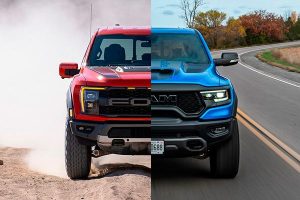
It’s also a great tool for dealing with SON protestors.
If you can afford it!
What It Is
The F-150 is Ford’s very popular half-ton pick-up, which is the best-selling vehicle in North America.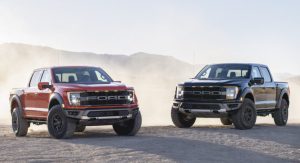
It competes with others in the same class such as the Chevy Silverado/GMC Sierra, the Ram 1500 and (to a lesser extent) the Toyota Tundra and Nissan Titan (which is apparently being discontinued, chiefly because it’s only available in a relative handful of configurations and so isn’t for just about everyone).
It comes in regular cab, extended cab and crew cab bodystyles, with a variety of different bed lengths, standard and available engines and in almost endless trim/styling configurations.
And then there’s the Raptor R.
It comes only in crew cab/short bed form and is the only iteration of the F-150 to come standard with (or even offer) the supercharged 5.2 liter V8 that’s basically the same engine that powers the ultra-performance Shelby GT 500 Mustang, detuned slightly from the 760 horsepower it makes in the Shelby. Which does not come with 37 inch tires, more than 13 inches of ground clearance, 14-15 inches of suspension travel or an 8,700 lb. tow rating.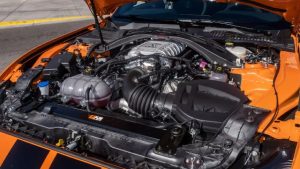
The price for this is $107,350 – which is the biggest obvious difference between the Raptor R and the Ram 1500 TRX, which stickers for a comparatively “affordable” $84,355.
So – what accounts for this difference?
Most of it probably has to do with the ultra-exclusive pedigree of the Raptor R’s Shelby GT 500 Mustang- sourced 5.2 V8, which is a dual overhead cam (rather than pushrod) V8 with a cross-plane crank and the ability to rev to more than 7,000 RPM. It is a more exotic as well as exclusive V8 than the TRX’s 6.2 Hemi, which has been installed in several other Dodge (and Jeep) models such as the Charger and Challenger Hellcats as well as the Grand Cherokee Trackhawk.
The Raptor R – italicized – is new.
Previously, there was just the Raptor – which had all the off-road upgrades and was similar to the TRX, but lacked a V8. It came standard with a 450 horsepower V6. And that was deemed to be not enough to tangle with the TRX’s standard V8.
Hence the R.
And now it’s a fair fight.
What’s Good
Shelby-sourced supercharged V8 is brutally smooth.
A Shelby Mustang that can carry five people and pull an RV.
More range than any EV.
What’s Not So Good
Cost differential between the Raptor R and the TRX – $22,995 – would pay for gas for the TRX for the next 5-6 years.
Does not offer something comparable to the “performance pages” app that comes standard in the TRX, which displays comprehensive real-time data about engine output and operating parameters, acceleration runs and so on.
You’d never know it had a blower by listening to it.
If you want to see the main reason for the almost $23k difference in price between the Raptor R and the TRX, just pop their hoods.
Both have supercharged V8s and they both make roughly the same 700 horsepower – but the Raptor R’s 5.2 liter, 700 horsepower V8 is much less common than the TRX’s 702 horsepower 6.2 liter V8. It is an engine that can only be found under the hood of one other – very rarely seen – Ford vehicle.
That would be the Shelby GT 500 version of the Mustang.
But why does that matter – beyond the exclusivity of owning a vehicle with a very rarely seen engine under its hood? Well, for the same reason that you might prefer a real Katana sword to a machete. Both will get the job done – but the one is a more elegant weapon than the other.
The 5.2 V8 in the Raptor is a 4 valve, DOHC engine with a cross-plane crankshaft and very high-RPM capability. In the Shelby GT 500 Mustang, the power peak (760 hp) isn’t reached until the tach needle swings to 7,000 RPM and peak torque (625 ft. lbs.) doesn’t manifest until 5,000 RPM.
It is a screamer, in other words. The Hemi 6.2 in the TRX is more a bellower.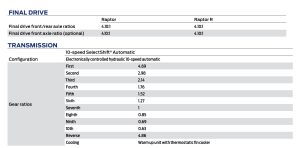
In the Raptor R, the Shelby’s 5.2 V8 has been tuned to produce its peak output at just over 6,000 RPM – and it makes more torque (640 ft.-lbs.) sooner (at 4,250 RPM) but its race car pedigree is no less evident. This is not a slam (at all) of the TRX’s Hemi V8, which is a mechanical animal in the very best sense.
It is – again – a matter of preferences that derive from differences.
There are some other differences as well. The Ford comes standard with a 10 speed automatic vs. the eight speed automatic that’s paired with the 6.2 Hemi in the TRX. The Ford’s two extra gears are both overdrive gears, with tenth gear being a very “deep” .063 ratio, which offsets the 4.10 final drive ratio such that cruise RPM at 70 is only about 2,200 RPM.
The Raptor’s Shelby-sourced engine also has an 11.5 quart oil capacity – which is nearly twice the capacity of the 6 quarts needed to fill up the regular Raptor’s (no “R”) 3.5 liter V6 after an oil and filter change. But then, you only need about half the oil – to lubricate and cool – when you’re only making a little more than half the power.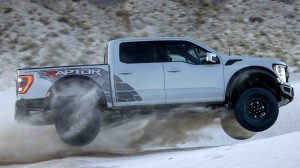
Towing capacity is another difference – between the Raptor R and the TRX. The latter is rated to pull 8,100 lbs. while the Ford can pull up to 8,700 lbs.
The 4WD system is selectable and you can select 2WD High (and turn the traction control off) which enables you to roast those ’37 inch gumball knobbies, guaranteed to make you smile and Greta cry.
On The Road
What happens when you put a Shelby GT 500’s engine in an F-150? Among other things you get to 60 in 3.6 seconds, which is quicker by a few tenths than the TRX – which is slowed down a little by the weight of its stamped steel vs. aluminum body. This latter difference accounts for a roughly 363 pound difference in curb weight between the two (6,440 lbs. for the TRX vs. 6,077 for the Raptor R).
Another difference is range.
The Raptor R comes standard with a 36 gallon tank, which gives it a Prius-like highway-driving range of 540 miles vs. 462 for the TRX (which has a 33 gallon tank). City driving range is less in both cases – 360 and 330 miles, respectively – but it’s still impressive given what you’re driving, either way.
And also relative to the only truck that’s slightly quicker (briefly) than both the Raptor R and the TRX. That would be the Rivian R1T electric truck, which can get to 60 in about 3 seconds flat. But it doesn’t go as far – best-case in 400 miles, maybe – and it always takes much longer to get going again. The Raptor R may only average about 13 miles-per-gallon but you can pump 36 gallons back into its tank in less than five minutes, as opposed to 80 percent charge in half an hour to 45 minutes (or longer) at a “fast” charger.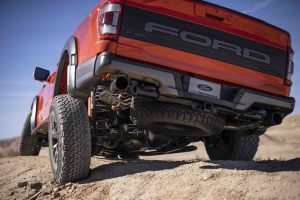
Assuming you can find one. Assuming it’s working. Assuming there isn’t someone else already plugged in.
The practical consequence of that is having to be chary about using the Rivian’s capability to get to to 60 in about 3 seconds. Do it more than a couple of times and you’ll be going a lot less far than whatever the advertised best-case range is. That’s also true as regards the Raptor R and the TRX – but it doesn’t matter because even if you drain their tanks dry in 200 miles of rompin’ you can refill them in minutes – and get back to rompin’.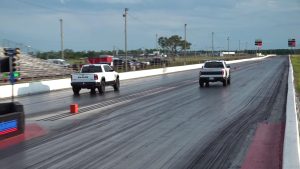
But the biggest difference – between the Raptor R and the TRX – is what you can hear vs. what you can’t. Both have blowers – i.e., superchargers – but you’d never know it to listen to the Raptor R. The 5.2 V8 sounds wonderful – especially when you select Sport or Baja using the button on the steering wheel that modulates the tone of the exhaust by increasing (or decreasing) the baffling in the pipes. But there’s almost no discernible blower whine, ever – which there always is in the TRX. Even at part-throttle, you can’t help but hear it – and that is either pleasant or not, depending on your preferences.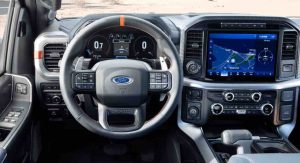
In Quiet mode, the Raptor R is almost electric car silent, which your neighbors will probably appreciate if you’re someone who heads off to work at 4 in the morning. It also lets you fade into the crowd, on the road – which you will appreciate, if there are cops around. It’s always sound policy to not call attention to yourself when you’re driving a vehicle that can get to 60 in just over 3 seconds.
Other than the sound – and the thrust – driving the Raptor R is remarkably like driving any other F-150. Which is remarkable because the Raptor is lifted 13 inches off the ground (and inch more than the TRX) and rides on 37 inch gumball knobbies, which you’d think would generate a lot of road noise, once you get rolling – as well as wallowing ride quality comparable to that of a water bed with on wheels. But this is not the case at all. Despite what this truck is capable of – on and off-road – it is as easy (and as comfortable) to drive on road as any other F-truck.
Excepting two points.
One, because it is lifted, you literally climb into it. Grab the handrail, pull yourself aboard. The texture-coated running boards help you keep your footing and provide a mid-point between the ground and way-up-there. But once you’re up there, it’s much the same as it is behind the wheel of a run-of-the-mill Lariat.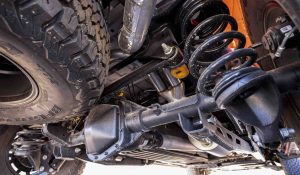
With one other exception.
Like all F-150s (and like all current half-ton trucks, including the TRX) the Raptor R’s width – especially when you include its mirrors – can make secondary roads can seem narrow – and parking spots laid out for cars too tight for this rig.
But you could always just park on top of whatever’s parked there. . . .
Like the TRX, the Raptor R touts what it’s packing via such things as fender flares and a front end designed to allow for steeper angles of approach and departure. There is also a bulging and louvered scoop on the hood but the difference here is it’s more of a bulge than a scoop.
The TRX’s scoop actually scoops.
The Raptor’s vents.
Likewise the ’70s Trans-Am emulating side vents on the front quarter panels; these allow hot underhood air to escape to the sides.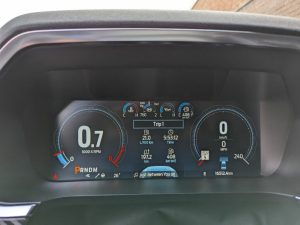
Other than these and a few other Raptor-specific clues, such as the tow hooks and min-LED lights – what you’ve got here is essentially the same thing as you’d have if you bought the TRX in that both are crew cab/short bed-half ton pickups.
But there are a few differences.
One is that first and second row legroom is more equally allocated in the Raptor R – 43.9 inches up front and 43.6 inches in the back, vs. 40.9 inches up front in the TRX and 45.2 inches in the rear. Even so, both trucks have plenty of room for five adult men – and that is one of the great appeals of these trucks in that they are far more comfortable for more people to ride in than any car.
Plus you have that bed out back.
Yes, it’s a short (five foot) bed but it’s still big enough to carry many times what you can carry in any car – or crossover, for that matter. The Raptor R’s even has a self-closing tailgate.
The Rest
One big difference between the Raptor R and the TRX is that the Ford doesn’t have anything like the TRX’s Performance Pages app, which includes a seemingly limitless array of displays ranging from accessory gauges for just about every imaginable engine/driveline parameter to a real-time dynamometer that tells you how much horsepower and torque the engine is making, as you’re driving, to lap timers, 0-60 and quarter-mile stopwatches and so on.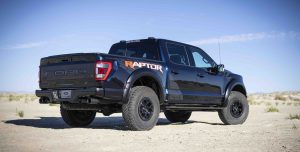
The Raptor does have scrollable digital gauges in the main cluster but they’re not as comprehensive.
On the other hand, the Ford does have a foldable gear selector that (when it’s folded) creates a kind of work space/table out of the center console.
The Ram hasn’t got that.
The Bottom Line
Both of these trucks are Hell on Wheels – in the best sense of that term. Which one is best isn’t the right question.
The right one is which of the two suits you better.
. . .
If you like what you’ve found here please consider supporting EPautos.
We depend on you to keep the wheels turning!
Our donate button is here.
If you prefer not to use PayPal, our mailing address is:
EPautos
721 Hummingbird Lane SE
Copper Hill, VA 24079
PS: Get an EPautos magnet or sticker or coaster in return for a $20 or more one-time donation or a $10 or more monthly recurring donation. (Please be sure to tell us you want a magnet or sticker or coaster – and also, provide an address, so we know where to mail the thing!)
If you like items like the Safety Cult T shirt pictured below, you can find that and more at the EPautos store!



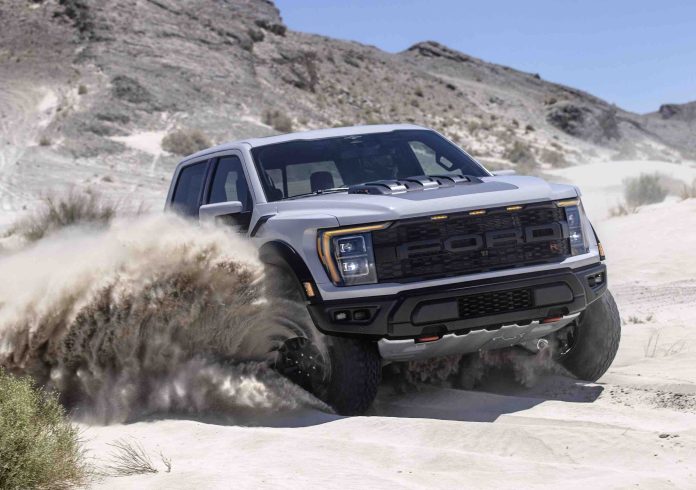










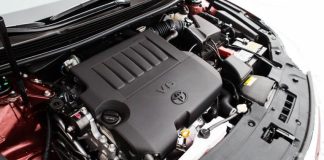
I wonder if the Rape-Tore has the leaky tail lamps with IR modules that corrode & disable the entire vehicle like the ‘Special-Ed’ does. $107K is a whopping price, especially with a built-in Achilles tendon.
Hi Graves!
Speed is always a question of money…
Wow. $107,350 for a truck.
My 4 bedroom, 2 full bath, full basement, .50 acre house is assessed at $105,000. Words fail me.
Hi Pug,
Yup – and now I have an Escape (an Escape!) that has an MSRP of $47k.
Escaahh-paaay!
My 2003 Escape was $24K, AWD and most of the extras. I gave it up in 2017 because I could not smog it in CA. Glad to be leaving CA in a month.
Thanks for the video ride along. That’s the closest I’ll get to a Raptor R. By the way, a dealership in Lexington had one advertised on its website for $50k OVER sticker! I looked again today to drool over it and it is gone. The new owner has to be smiling like a Powerball winner!
Indeed, Allen –
It’s gone now. They took it back yesterday. And now I have an Escape hybrid in its place. Would you believe this thing – the Escape – stickers for $47k?
And they ask me why I drink…
Good to see some beasts being produced that will make Greta and Al cry.
That alone is worth it.
Both of these are practically Monster Trucks. Their utility as “daily drivers” would be Marginal.
Maybe if you commuted from way out in the boondocks at the end of 20+ miles of extremely “unimproved” roads, they might make sense. You could get to and from really fast, while hardly feeling the horrific bumps. ( I did exactly that for one year, in a 3/4 ton, V-10 Dodge Ram. Was plenty fast, with good off road ability. But you could really feel all the bumps. Took the fun right out of it.)
However, if this is the kind of thing you can afford to buy as just another toy….Go For It! And Drive Hard. 🙂
RE: “Maybe if you commuted from way out in the boondocks at the end of 20+ miles of extremely “unimproved” roads”
…Sounds like a perfect description of a highway at midnight after working a double shift and 6″ – 12″ of fresh icy slushy snow. …In just about anywhere in The Northland.
…Or, every city street in the same conditions. Esp in Blue cities.
If either pickup were south of $12,000 I’d get one in a heartbeat.
Hi Mike,
Yes, but…
I get why people (who can afford them) buy them in lieu of performance cars. I love the current Mustang; it’s the fastest/quickest Mustang ever made and it is all kinds of fun to drive it. But it is as practical as a bikini in Antarctica. It requires (for most people) another vehicle to do the things you can’t realistically do with it, such as carry more than one passenger or anything else. This truck easily carries five adults, or two adults (up front) and four kids in back. Plus it has that bed. Plus it is great in the snow. Plus it can tow.
The shame is what it costs.
“It’s also a great tool for dealing with SOL protestors.”
Not sure what “SOL” protesters means.
SOL typically means Shit Outa Luck, or in astrology the sun.
https://www.acronymfinder.com/Slang/SOL.html
Stupid Obnoxious Losers?
Probably Eric meant SON — Stop Oil Now protesters, referenced two paragraphs above.
But yeah … after getting plowed under with a 3-ton monster pickup, they will be beyond SOL … more like DOA.
Some guy at a gas station proudly showed me his new truck, a Ford Bronco Sport with a 1.5 liter 3 cylinder which he said he gets 20-30 mpg. He even showed me the engine, and I quickly located the 3 injectors and 3 plug wires confirming it to be 3 cylinders.
I looked it up on the EPA fuel economy ratings – see this:
https://fueleconomy.gov/feg/bymodel/2022_Ford_Bronco_Sport.shtml
2022 Ford Bronco Sport
City MPG:25
Highway MPG:28
It looked good. Along with the Maverik and F-150, I think those models could save Ford from bankruptcy from Lightning and the EV fiasco.
Lesson learned – never let a corrupt pedophilia criminal scumbag political class talk you into building electric cars.
I wonder what the big cars of today would have been like, had they not be outlawed ur, regulated away.
Guessing we see what would have been in these trucks, which are pretty amazing when you consider what they are. They are big, are comfy to ride in, have V8 engines (for now anyway).
In a lot of ways the tail fins of the 50’s live on today, they are just truck bed walls now…….
Of course I’d like a new body-on-frame LTD station wagon as such (with bench seat in front and middle rows, and 2 sideways-facing seats in the way back)
‘Hence the R.’ — eric
Or as the lawyers write it, THE NEW 2023 FORD F-150® RAPTOR R™.
The circled ® means registered with the Patent and Trademark Office.
But R™? What does this R stand for? And is Ford trademarking ‘R’ or ‘Raptor R’?
Questions, questions! Have to say, the pedantic R™ is like a bucket of cold water over the head, leading one to suspect that the second R may stand for Retentive, as in Anal.
Hope they don’t include that silly ™ in the badging.
© Jim H, 2023
You need to find a nice off-road test for these trucks. Not just mud, but some steep climbs, different soils and tests to try out the various 4WD capabilities.
Maybe work with a local outfitter to see what factory addons make sense and which don’t.
Your car reviews are right on the money, but sometimes the truck test on highways don’t tell the story. Even if 90% of these things aren’t ever going to get dirty.
Expensive toy.
Eric, you really ought to consider doing a follow up article on How To Successfully Complete The Pharmaceutical Importation Run to pay for this rig. Maybe a guest post by someone using a pseudonym. I dunno.
Easy Rider redux, using 21st century technology. It’s a longgg border, and not all that well guarded, from what I hear… 🙂
Another observation: High end trucks are the only American vehicles available with neck snapping acceleration and a bunch of horsepower. The dated Mustang still has it, but that car is largely unusable. Chevy and Dodge are discontinuing their Camaros and Challengers soon.
To get any decent amount of power, you have to spend 50k plus. Disgusting.